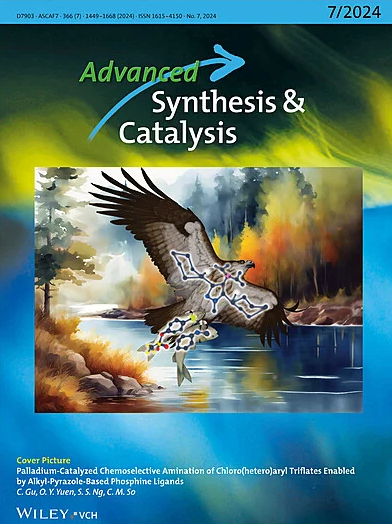Merging Cu2O Photo‐Thermo‐Catalyst with Lignosulfonate‐Supported Tempo for Aerobic Oxidation of 5‐Hydroxymethylfurfural into 2,5‐Diformylfuran
IF 4
2区 化学
Q2 CHEMISTRY, APPLIED
引用次数: 0
Abstract
The selective oxidation of 5‐hydroxymethylfurfural (HMF) into 2,5‐diformylfuran (DFF) represents a critical step in the sustainable synthesis of high‐value chemicals from renewable biomass. A significant challenge in achieving this transformation lies in developing an effective visible light‐driven heterogeneous photocatalytic method that excludes the use of dye‐based sensitizers. While solar energy presents an exceptionally promising renewable energy source for extensive future applications, its overall utilization remains suboptimal. To address these challenges, we introduce an innovative photo‐thermo‐catalyst system comprising octahedral Cu2O particles, which, when combined with lignosulfonate (LS)‐supported 2,2,6,6‐tetramethylpiperidinyloxyl (TEMPO), demonstrates decent catalytic performance for the selective oxidation of HMF into DFF under the illumination of a 400 nm light‐emitting diode light. This system achieves a remarkable 95% DFF yield at 60 °C under ambient oxygen conditions. This study successfully demonstrates the effective integration of a non‐noble metal photo‐thermo‐catalyst with a supported TEMPO system, which enables the efficient HMF‐to‐DFF transformation driven by visible light, eliminating the need for dye sensitizers in the process.

合并Cu2O光热催化剂与木质素磺酸负载的Tempo用于5-羟甲基糠醛的好氧氧化成2,5-二甲酰呋喃
5-羟甲基糠醛(HMF)选择性氧化生成2,5-二甲酰呋喃(DFF)是可再生生物质可持续合成高价值化学品的关键一步。实现这一转变的一个重大挑战在于开发一种有效的可见光驱动的多相光催化方法,该方法不包括使用染料基敏化剂。虽然太阳能是一种非常有前途的可再生能源,具有广泛的应用前景,但其总体利用率仍不理想。为了解决这些挑战,我们引入了一种由八面体Cu2O颗粒组成的创新光热催化剂体系,当它与木素磺酸盐(LS)支持的2,2,6,6-四甲基哌替啶酰氧基(TEMPO)结合时,在400 nm发光二极管的照明下,对HMF选择性氧化成DFF表现出良好的催化性能。该体系在60°C环境氧条件下的DFF产率达到了95%。该研究成功地证明了非贵金属光热催化剂与支撑的TEMPO系统的有效集成,该系统能够在可见光的驱动下实现hmf到dff的高效转化,从而消除了该过程中对染料增敏剂的需求。
本文章由计算机程序翻译,如有差异,请以英文原文为准。
求助全文
约1分钟内获得全文
求助全文
来源期刊

Advanced Synthesis & Catalysis
化学-应用化学
CiteScore
9.40
自引率
7.40%
发文量
447
审稿时长
1.8 months
期刊介绍:
Advanced Synthesis & Catalysis (ASC) is the leading primary journal in organic, organometallic, and applied chemistry.
The high impact of ASC can be attributed to the unique focus of the journal, which publishes exciting new results from academic and industrial labs on efficient, practical, and environmentally friendly organic synthesis. While homogeneous, heterogeneous, organic, and enzyme catalysis are key technologies to achieve green synthesis, significant contributions to the same goal by synthesis design, reaction techniques, flow chemistry, and continuous processing, multiphase catalysis, green solvents, catalyst immobilization, and recycling, separation science, and process development are also featured in ASC. The Aims and Scope can be found in the Notice to Authors or on the first page of the table of contents in every issue.
 求助内容:
求助内容: 应助结果提醒方式:
应助结果提醒方式:


